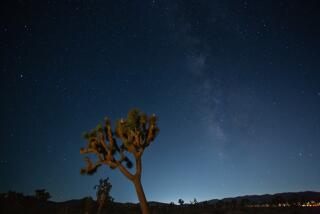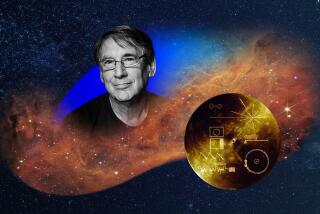Wide-Angle Wizardâs Photos Go On and On
HARTFORD, Conn. â This guy sure doesnât seem to be taking pictures. In fact, he looks downright suspicious, hanging out of a hovering helicopter and dangling sinister-looking contraptions over unsuspecting cities and towns.
Wide-angle wizard Michael Lawton, prince of the panoramas, is a master at producing startling photographs that encompass more of a scene than you can see with your own eyes. Right now, heâs taking a circular portrait of Norwich, Conn.--all of it--that will make the city look like a planet floating in outer space.
Up here in the blue sky 800 feet above Norwich, the Glastonbury, Conn., image-impresario is working color-coded ropes that control a fisheye camera as if it were a Buck Rogers-type marionette. (The only way to avoid including the helicopter in the finished picture is to suspend the camera on ropes that allow it to hang below the chopper. Once deployed, the camera is operated as if it were a puppet on strings.)
Lawtonâs fisheye camera is a hatbox-size black cube bristling with black and silver cylinders. Hidden in the futuristic-looking gizmo are whirring gyroscopes (to stabilize the camera), a whooshing vacuum pump (to hold the film perfectly flat, thereby ensuring the sharpest possible image), purring motors (to advance the film after each picture is snapped) and a shutter that clicks each time Lawton presses the red button at the end of a long gray cord.
Tackles âImpossibleâ Jobs
Lawton designed and built this crazy camera, and itâs one in a long line of continually evolving prototypes that he has developed to tackle seemingly impossible photographic tasks, jobs like photographing a group of astronauts inside a claustrophobic space capsule or Fenway Park, showing both the cheering guy in the next seat and an outfielder snagging a fly ball.
To get those kinds of photographs, Lawton has designed and built cameras that take panoramic pictures (encompassing a full 360 degrees); fisheye cameras (whose omnivorous lenses swallow up 180-degree views and render them in circular images), and all sorts of esoteric picture-taking gear constructed by cannibalizing such traditional cameras as Nikons and Hasselblads.
But, Lawton says, âIâm not building cameras; Iâm building pictures.â
Each of his cameras has been designed to solve a specific photographic problem. He says he has developed a way to capture at least one photograph many consider impossible: the space shuttle engulfed in a shower of sparks as it re-enters the Earthâs atmosphere. Astronauts have seen the glow, but they canât get a decent photo from inside the shuttle. âIâve figured out a way to do it,â Lawton says. âBut thatâs my little secret.â
Lawton embarked on his singular photographic specialty with one of his first commercial assignments in the early â70s. Attempting to photograph a stadium in San Diego, he realized that it was impossible to get a good, undistorted picture showing the whole stadium on a single frame of film. He used three, then tinkered for hours in a darkroom to combine the separate negatives into a single, acceptable black and white print. Great, his client said, but wanted to see one in color. It took three months and $1,700 worth of retouching, but Lawton finally succeeded.
He also realized that there had to be a better way to do this sort of thing.
Panoramic Photos
Holing up with a model-making buddy, he went to work to develop a camera that could take panoramic pictures. âWe kind of went nuts for three years,â he says. The inventors were so single-minded that Lawtonâs thriving $40,000-a-year business nose-dived to one netting only $5,000 a year. But one day, the duo emerged from Lawtonâs garage with a piece of film worth processing--a picture of the garage. At the photo lab, technicians were bowled over by seeing a continuous, seamless strip of film that showed the back and side walls inside the garage and the house across the street (seen through the open garage door)--again and again.
Lawtonâs invention was a vast improvement over commercially available panorama pictures: It included more of the scene and rendered razor-sharp images.
Thus his career was launched. âI figured if I could excite people with the inside of my garage, what could I do with the Grand Canyon?â Lawton says.
So he photographed the Grand Canyon, then the Golden Gate, then Yosemite, and on and on. He made and sold a slew of posters. The idea was to shoot the cliches with a new twist and prove to the publishing world the viability of panoramic photography.
But all he met was resistance. The problem was that those long, skinny panoramics didnât work with any of the book or magazine formats in the â70s. To be best appreciated, the pictures have to be large. (Only in the past 10 years or so has National Geographic, for example, perfected the technology needed to publish multiple-page fold-out panoramic photographs on a regular basis.)
Lawton, 46, spent the early part of his photographic career working as a free-lancer for National Geographic, but his association with the magazine ended before it was able to easily print the kind of pictures he makes best. Along the way, he also represented Canon cameras in a splashy ad campaign that capitalized on his photographic involvement with NASA.
Shoots Everything
Today most of Lawtonâs work comes from developers and advertising agencies. Using his unique aerial fisheye and panoramic perspectives, or more traditional photo gear, Lawton shoots everything from junkyards to jungles.
Such day-to-day work is merely a springboard to Lawtonâs real passions: exploration and adventure. Not only does his free-lance work pay the bills, but it also helps him hone his techniques. âIâm practicing with someone elseâs money,â says Lawton of his free-lance assignments, âso when Iâm out in the middle of the sticks I can come back with something.â
Lawtonâs last trip was to the Roraima complex in southeastern Venezuela, the alien landscape that inspired Sir Arthur Conan Doyleâs tale of adventure entitled âThe Lost World.â
Once at Autana, a mesa-like sandstone monolith, Lawtonâs group descended to explore a cave so vast that a daring helicopter pilot flew right into it. It was a luxurious sort of expedition--twice the group sent helicopter pilots on a 2 1/2-hour mission for cold soft drinks and ice. There was an element of daring whimsy as well--sky divers parachuted off the monolithâs summit, plunging nearly a mile to reach the rain forest floor.
Lawton returned with a series of stunning photographs he hopes will help focus attention on the endangered rain forests of the Amazon Basin. One of his mural-size prints shows a vast tract of tropical jungle punctuated by a tiny burned-out, chopped hole--perhaps the beginning of a farm or ranch.
âThe whole idea is to start to build upon that theme--the destruction of the rain forest,â Lawton says. âThere are some estimates that there could be no rain forest in Venezuela in 20 years.â
Ancient cities also intrigue Lawton, who might like nothing better than the chance to do a high-altitude, infrared scan of, say, the Peruvian Amazon, in search of communities lost to time.
More to Read
Only good movies
Get the Indie Focus newsletter, Mark Olsen's weekly guide to the world of cinema.
You may occasionally receive promotional content from the Los Angeles Times.










